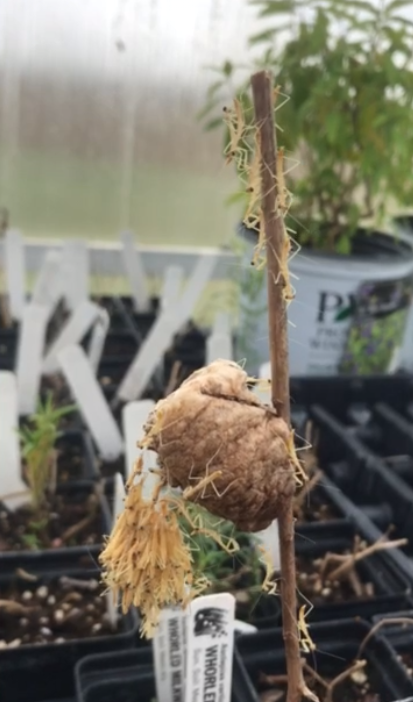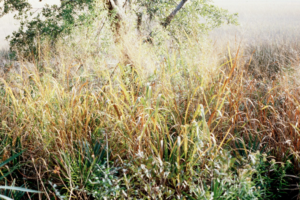In our greenhouse and nursery, I work very hard to create a hospitable environment for pollinators and wildlife. This means limited use of pesticides and herbicides. Unfortunately, greenhouse pests flourish when uncontrolled and can lead to devastating crop losses. They affect the appearance of our plants, which in turn affects how well they sell. This year, to minimize my use of insecticidal soap spray, I tried using Mantises as greenhouse predators instead.

Finding and Identifying Egg Cases
While cleaning garden beds this spring, I found many mantis ootheca (egg cases) hanging on branches of shrubs and trees. The egg cases can easily be spotted in areas of dense vegetation that stay standing through the fall and winter. Non-native mantis ootheca are round and bulbous, but native North American mantises (Stagmomantis carolina) have a long, flat egg case resembling a tiny trillobite.
I carefully cut the cases away from the parent plant, leaving the egg sac attached to its branch. I then placed those egg sacs in our unheated greenhouse, sticking the end of their twig into potted plants that often get pest problems in early spring.

For two months, nothing happened. But in mid April when the days were consistently sunny and warm, they finally hatched out in a giant wriggling mass!
They were fun to watch, and they dispersed themselves all across the greenhouse. But when it comes to aphid control, they were not voracious enough. In the past I used lady bugs and parasitic wasps as predators, both of which preyed on more aphids and at a faster rate than the mantises.
Do Not Order or Buy Mantises
I would not recommend ordering mantises from any garden center or organic pest control website — often they send the non-native type that are more likely to cause problems than solve them. Mantises are indiscriminate, and eat beneficial insects like bees, caterpillars, and even prey on hummingbirds.
I had fun experimenting with them because they were readily available to me on our grounds, but I would otherwise be cautious of using a nonnative insect for pest control. The best pest control method for residential gardens is a diverse planting that attract lots of pollinators and predators. These insects will find a balance amongst themselves!


